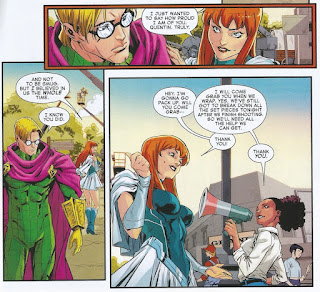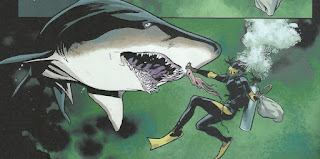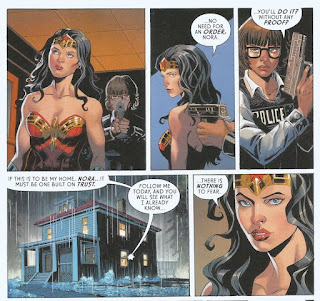Pick of the Brown Bag
February 19, 2020
Part Two
by
Ray Tate
In part two of the POBB, I examine the merits of The Amazing Mary Jane, Captain Marvel, Fantastic Four and Ghost Spider. I posted the Twitter version of the POBB days ago: #PickoftheBrownBag. So if you need a decision right now and haven't time to read the entirety of the blog, you know where to go.
A Big Bad that you likely never heard of named Vox Supreme captured Captain Marvel. He stuck her in a bugged and controllable nano-suit. He then threatened the lives of innocent people should Carol not do his bidding. These demands consist of killing the Avengers and bringing their bodies to him.
Carol came up with an alternate scheme. Fight the Avengers, yes. Defeat them, yes, but hide them in a living, pocket dimension of her acquaintance and give Vox Supreme conveniently cloned bodies, already dead.
This issue, Carol faces the She-Hulk. She fought the She-Hulk before, but only as a friend. Because of the mask, She-Hulk thinks of Carol as an enemy. So, only holding back a little.
The way in which Carol defeats the She-Hulk is pretty clever, and the nod to A-Force is welcome.
I had misgivings about the start of this story, and I'm still unimpressed by Vox Supreme who looks like a ragged cross between a Predator, Venom and a Mandalorian. This however is a pre-existing character. So not entirely Kelly Thompson's fault. In any case, the story shaped up by the second chapter and steamed along without letting up. Part of the successful energy in Captain Marvel can be credited to former Batman and Loki artist Lee Garbett as well as colorist Tamra Bonvillain.
Thompson though should be given major props for making a story out what seems to be leftovers: Singularity from Thompson's own defunct A-Force, cloned Avengers and some goof from a low-rent Inhumans mini-series. I had to look up that last one.
Dan Slott concludes the Fantastic Four story involving the planet Spyre. He furthermore sets up the pieces for the next tale which involves Wyatt Wingfoot and the Mole Man.
On the planet Spyre, Avengers/Thunderbolts knock-offs greeted the FF as foretold enemies. Things smoothed out, but the FF learned a terrible secret. That knowledge catalyzed Ben Grimm to lead a pack of so-called monsters against the pretty boy superheroes of the world. For the most part this was all Outer Limits fun and games until an even more awful, personal revelation occurred. That divulgence resulted in catastrophic damage.
Ben may have ripped apart their culture. That still doesn't absolve the Overseer whose crimes against science and the FF instill in Reed a rare physical rage.
That's the Overseer in the Lex Luthor armor. Sue kind of gets off on Reed getting medieval, which is proper for her persona and wrong ethically. So, it's a nice demonstration of Sue just being a fallible human but without making her a liability to the team.
Sue's a little kinky. Perfect expression. Speaking of relationships, Spyre pairs up people based on some sort of funky science. This was largely an excuse to give Johnny a girlfriend in Skye.
Lovely colors on the wings. Skye joins the FF on their journey back home. Thus, keeping the tradition of Franke Raye and Crystal alive. Fantastic Four is just good solid adventure writing from Dan Slott and artwork from Sean Izaakse. As with Captain Marvel, I didn't really care for the opener, but as each chapter dropped the story became respectable.
The reliable Ghost Spider doesn't disappoint. Last issue, writer Seanan McGuire revealed that the Johnny and Sue Storm of Ghost Spider's parallel earth diverged from our more familiar sibs. They never became astronauts, nor were they bombarded by cosmic rays. Instead, they became influencers, until one day they disappeared.
What Gwen said. The Storms return without explanation for their four year absence, and they seem to be the real thing.
Ghost Spider though curious turns her attention to crime.
Before Gwen can demonstrate her arachnid abilities. Somebody distracts the gunmen with flame. Hmmmn. Gwen's no mean detective, but it doesn't take Sherlock Holmes to add two and two.
One thing's for certain, the Maker had nothing to do with it. He's as surprised at the Storms' return as everybody else. Wait? What's Reed Richards' evil doppelgänger doing in Ghost Spider?
McGuire gives readers and Ghost Spider a puzzle to solve or a knot to untangle each issue. In addition, McGuire weaves a consistent web similar to the ongoing day-to-day comic strip.
Gwen is going to school on Earth Marvel Proper, only this time she skips class because she overslept for reasons involving her father. Gwen once empowered by the bite of a spider, now derives her abilities from a suit knit together by symbiotic spider-like creatures. As such, she must feed them, something starchy. As well we get Ig Guara illustration and Ian Herring colors. So there's always something interesting going on in Ghost Spider, and Gwen looks great doing whatever that something may be.
Amazing Mary Jane concludes with the redemption of Quentin Beck alias Mysterio. Yeah, I know he can be battling Spider-Man somewhere, some title soon. I mean, hell, I thought Mysterio pined for the fjords. I guess if Norman Osborn can come back. So can Mysterio.
For this moment, Beck accomplished what he set out to do. Make a movie of his life with Mary Jane Watson portraying his henchwench/ love interest.
Incidentally, the relationship is just an act. One of the best things about the story. Mysterio doesn't get all scuzzy like Norman Osborn. He respects Mary Jane as a fellow artist.
Beck made this film on the up and up, mostly. Beck created the illusion of Cage McKnight while he sent the real auteur on a penguin expedition. With Mary Jane's help, he secured all the funding. He attracted a big name actor. He also offered some fellow felons some honest coin.
You really could not help but to root for Mysterio.
There's just one fly in the ointment. Some of Mysterio's fellow rogues aren't too keen on their portrayals. They spooked the Spider-Man star, and after a particularly devastating humiliation, they've taken names, including Mary Jane's.
Mary Jane put her heart and soul in the movie to gain a good part and to keep Mysterio on the road to redemption. That means, she's got a lot of fans in her corner.
The big dukeroo illustrated by Red Sonja's Carlos Gomez makes excellent use of Mysterio's powers and B to C List Spider-Man foes. Gomez also contributes a cool double page spread of practical special effects that MJ uses in her defense that would have otherwise appeared as culled together random images if not for his expertise.















































































